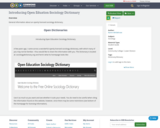
General information about an openly licensed sociology dictionary.
- Subject:
- Sociology
- Material Type:
- Student Guide
- Author:
- Ramin Mirfakhraie
- Date Added:
- 09/19/2021

General information about an openly licensed sociology dictionary.

This course provides an overview of Asian American history and its relevance for contemporary issues. It covers the first wave of Asian immigration in the 19th century, the rise of anti-Asian movements, the experiences of Asian Americans during WWII, the emergence of the Asian American movement in the 1960s, and the new wave of post–1965 Asian immigration. The class examines the role these experiences played in the formation of Asian American ethnicity. The course addresses key societal issues such as racial stereotyping, media racism, affirmative action, the glass ceiling, the “model minority” syndrome, and anti-Asian harassment or violence. The course is taught in English.

A resource providing sociological perspectives on criminological study and theories.

Why do affluent, liberal, and design-rich cities like Minneapolis have some of the biggest racial disparities in the country? How can designers help to create more equitable communities? Introduction to Design Equity, an open access book for students and professionals, maps design processes and products against equity research to highlight the pitfalls and potentials of design as a tool for building social justice.

This is a comprehensive overview of eating disorders and associated issues, containing 13 chapters and aimed at an undergraduate psychology or sociology audience.

An Anthropological and Comparative Approach
Word Count: 49859
(Note: This resource's metadata has been created automatically by reformatting and/or combining the information that the author initially provided as part of a bulk import process.)

This course examines major social and political trends, events, debates and personalities which help place aspects of contemporary French culture in their historical perspective through fiction, films, essays, newspaper articles, and television. Topics include the heritage of the French Revolution, the growth and consequences of colonialism, the role of intellectuals in public debates, the impact of the Occupation, the modernization of the economy and of social structures. The sources and meanings of national symbols, monuments, myths and manifestoes are also studied. Recommended for students planning to study abroad. Taught in French.

As an introduction to the field of Housing, Community, and Economic Development (HCED), the course is structured to:
Advance student’s understanding of how public policy and private markets affect housing, economic development, the local economy, and neighborhood institutions;
Provide an overview of techniques for framing public and private interventions to meet housing and community development agendas, broadly defined, of inner city and low income neighborhoods;
Review and critique specific programs, policies and strategies that are (and have been) directed at local development and neighborhood regeneration issues;
Give students an opportunity to reflect on their personal sense of the “housing, community, and economic development” process and the various roles that planners play in implementing the elements of that agenda.

This course provides students with a critical introduction to: social and economic inequality in America; equitable development as a response framework for planners; social capital and community building as planning concepts; and the history, development, and current prospects of the fields of housing (with an emphasis on affordability and inclusion) and local economic development.

Interdisciplinary introduction to contemporary Latin America, drawing on films, literature, popular press accounts, and scholarly research. Topics include economic development, ethnic and racial identity, religion, revolution, democracy, transitional justice, and the rule of law. Examples draw on a range of countries in the region, especially Mexico, Chile, and Brazil. Includes a heavy oral participation component, with regular breakout groups, formal class presentations on pressing social issues (such as criminal justice and land tenure), and a structured class debate.

This course is designed as an introduction to Latin American politics and society for undergraduates at MIT. No background on the region is required. Overall workload (reading, writing, class participation, and examinations) is similar to that of other HASS-D courses. Many of the themes raised here are covered in greater detail in other courses: 21G.020J (New World Literature), 21G.716 (Introduction to Contemporary Hispanic Literature), 21G.730 (Twentieth and Twentyfirst-Century Spanish American Literaturere), 21G.735 (Advanced Topics in Hispanic Literature and Film), 21A.220 (The Conquest of America), 21H.802 (Modern Latin America), 3.982 (The Ancient Andean World), 3.983 (Ancient Mesoamerican Civilization), 17.507 (Democratization and Democratic Collapse), and 17.554 (Political Economy of Latin America).F
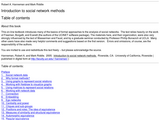
This on-line textbook introduces many of the basics of formal approaches to the analysis of social networks. The text relies heavily on the work of Freeman, Borgatti, and Everett (the authors of the UCINET software package). The materials here, and their organization, were also very strongly influenced by the text of Wasserman and Faust, and by a graduate seminar conducted by Professor Phillip Bonacich at UCLA. Many other users have also made very helpful comments and suggestions based on the first version.
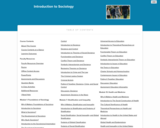
Introduction to Sociology
There is perhaps no course more immediately impactful and relevant to students’ lives than sociology. This course provides a comprehensive overview of key sociological topics and encourages students to think critically about the social world. Students develop the sociological imagination and examine society through each of the main sociological paradigms. The course includes embedded practice questions with targeted feedback to encourage reflection and application, as well as videos, discussions, and assignments.
Key topics include research, culture, socialization, society and groups, deviance and crime, stratification and inequality, race and ethnicity, gender, sex, and sexuality, marriage and family, religion, education, health and medicine, aging and the elderly, government and politics, work and the economy, population and urbanization, and social change. Faculty members may readily adapt the course’s OER content to include new developments and research to equip students with what they need to have success in their sociological journey.
Contributors
This course, based on the OpenStax 2e Sociology text, was developed by Lumen Learning and includes additional noteworthy contributions by the Lumen Learning team and:
What’s New?
The 2019 edition of Introduction to Sociology includes the following significant improvements and enhancements:
Improved course organization
Modules are more consistent in size. This means some modules have been separated out from the previous version of the course. This enables greater instructor flexibility and more manageable learning for students.
Content is organized around specific, granular learning outcomes, which are listed at the top of each page.
Practice questions, try it questions, and quiz questions all align with learning outcomes.
Improved course content
Course content was reviewed for accuracy and currency, then updated with modern examples, news, and research.
“Try It” embedded practice questions for every learning outcome. This means that students learn about concepts and then immediately check their understanding with applied practice.
“Watch It” embedded videos that explain and reiterate key concepts throughout the course.
Most videos come from CrashCourse Sociology, although several others are included from various sources such as Khan Academy and Sociology Live!
Discussions and Assignments for every module
As a Waymaker course, this is customizable and delivered with user-friendly personalized learning tools to strengthen engagement and student success. There are formative self-check assessments and summative quiz questions that can be imported directly into the LMS.
Pacing
The Introduction to Sociology course contains eighteen modules. Since many instructors choose not to teach every module, sometimes it works well to cover roughly one module per week for a sixteen-week semester. Although the modules are generally similar in size, some of the content is lighter in certain modules or more dense in others, so it may make sense to combine some modules in one week or draw out other modules over several weeks. See the “Pacing” page inside of faculty resources for more information and suggestions.

Exploring the World Around Us
Short Description:
Note: This OpenStax book was imported into Pressbooks on October 27, 2021, to make it easier for instructors to edit, build upon, and remix the content. The OpenStax import process isn't perfect, so there may be a number of small errors. This also means that, while the original version of this book is accessible, this Pressbooks copy is not. For information about how to get your own copy of this book to work on, see the Add Content part in the Pressbooks Guide. You can access the original version of this textbook here: Introduction Sociology 2e: OpenStax.
Long Description:
This OpenStax book was imported into Pressbooks on October 27th, 2021, to make it easier for instructors to edit, build upon, and remix the content. Introduction to Sociology 2e adheres to the scope and sequence of a typical, one-semester introductory sociology course. It offers comprehensive coverage of core concepts, foundational scholars, and emerging theories. The textbook presents section reviews with rich questions, discussions that help students apply their knowledge, and features that draw learners into the discipline in meaningful ways. The second edition has been updated significantly to reflect the latest research and current, relevant examples.
Changes made in Introduction to Sociology 2e are described in the preface to help instructors transition to the second edition. The first edition of Introduction to Sociology by OpenStax is available in web view here.
Word Count: 242381
(Note: This resource's metadata has been created automatically by reformatting and/or combining the information that the author initially provided as part of a bulk import process.)
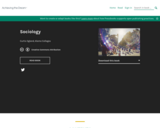
Word Count: 254838
(Note: This resource's metadata has been created automatically by reformatting and/or combining the information that the author initially provided as part of a bulk import process.)
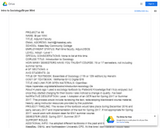
Most of you come into this class asking yourself, “What is sociology?” Good question, I found myself asking that same question in high school during my first sociology class. In short, sociology is the study of society. I define sociology as seeing society from a view point other than your own. In a society where we stress individualism more and more every day, this becomes more difficult to understand or contemplate. Through this class, students will learn to see society through a set of different eyes. Students will see how social theory and research shape the decisions we make, the social change we desire, and the social constructs around us.
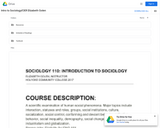
Sociology enables us to make observations and insights into the social world. Our aim in this course is to develop a sociological perspective by addressing a series of broad questions regarding the society we inhabit. We will work together throughout the semester to analyze and develop a deeper understanding of the social world through the lens of sociological inquiry. Along the way, you will become familiar with the substantive topics within the field of sociology. We will also begin to develop critical thinking skills with a focus of application to the real world and current events.
Pedagogy: This class is web-enhanced and therefore has substantial online content. To encourage participation and increase ease of access for the maximum number of students, participants can complete assignments online instead of physically attending class without any negative repercussions.
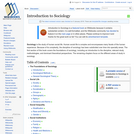
Sociology is the study of human social life. Human social life is complex and encompasses many facets of the human experience. Because of the complexity, the discipline of sociology subdivided over time into specialty areas. The first section of this book covers the foundations of sociology, including an introduction to the discipline, the methods of study, and some of the dominant theoretical perspectives. The remaining chapters focus on the different areas of study in sociology.
Introduction to Sociology is a featured book on Wikibooks because it contains substantial content, it is well-formatted, and the Wikibooks community has decided to feature it on the main page or in other places. Note: See "Instructor Resources" to find a list of Course Adoptions and accompanying PPTs.
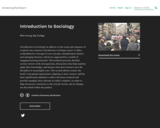
Short Description:
Introduction to Sociology 2e adheres to the scope and sequence of a typical, one-semester introductory sociology course. It offers comprehensive coverage of core concepts, foundational scholars, and emerging theories, which are supported by a wealth of engaging learning materials. The textbook presents detailed section reviews with rich questions, discussions that help students apply their knowledge, and features that draw learners into the discipline in meaningful ways. The second edition retains the book’s conceptual organization, aligning to most courses, and has been significantly updated to reflect the latest research and provide examples most relevant to today’s students. In order to help instructors transition to the revised version, the 2e changes are described within the preface.
Word Count: 125254
(Note: This resource's metadata has been created automatically by reformatting and/or combining the information that the author initially provided as part of a bulk import process.)
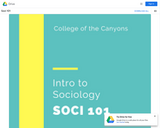
Intro to Sociology / SOCI 101
Examines small group interactions and cultural patterns of American and other societies using the conceptual, theoretical, and methodological principles and applications to explain how values, roles, norms, social interaction, and social inequality as well as other concepts influence individuals, groups, and society.